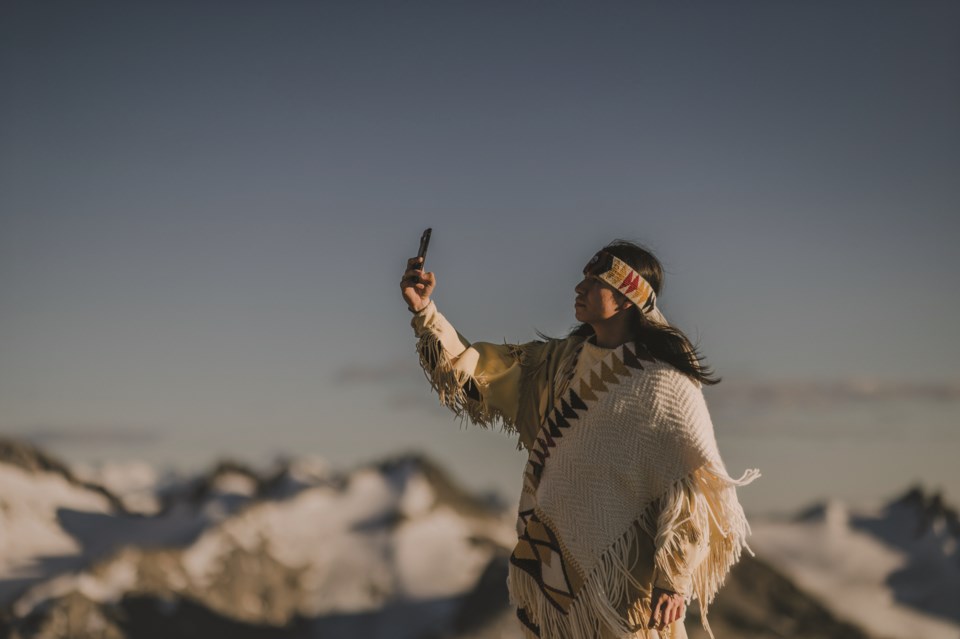The team behind Unceded, a new exhibit at the Squamish Lil’wat Cultural Centre (SLCC), has a hard time choosing just one stand-out image from the epic, months-long photoshoot.
Still, it’s hard to imagine the helicopter trip up to Black Tusk with dancers and drummers in full regalia, captured during the alpine sunset, wasn’t particularly memorable.
“It’s difficult to pick the shoots that stand out to me, as all of them were so important,” says photographer Logan Swayze, in an email. “Of course the Black Tusk shoot was incredible, getting to witness the performance team dancing and singing at sunset in that beautiful place, flying and shooting with the door off the helicopter.”
But then, it was also meaningful to do a shoot in downtown Vancouver at dusk as the Vancouver Police Department directed traffic. Or spend time in the early morning at the Nicklaus North Golf Course with Nstinemqen William Ritchie and hear his stories about that land during his younger years.
“All of the sessions were a pleasure and a great honour to photograph, really because of the wonderful people involved and the stories they shared,” Swayze said.
In any photo exhibit, stunning pictures might be at least part of the point, but, in this case, there was much more to the project’s purpose.
“Really, the whole idea was to highlight the Lil’wat and Squamish Nations’ view of the land and connection to it,” says Mixalhítsa7 Alison Pascal, a Lil’wat Nation member who co-curated the show with Tsawaysia Dominique Nahanee from the Squamish Nation.
“The whole title, Unceded, from my experience, how we connect to the land is sometimes misinterpreted. In Lil’wat Nation we’re called Ucwalmícw—people of the land. We don’t believe we own the land, like, ‘This is my property, this is my possession.’ In our worldview, we’re a part of the land and the land is a part of us.”
Pascal and Nahanee conducted research, worked with elders and consulted other members of the community to help choose locations for photoshoots—which span from K’emk’emeláy (Vancouver) to Ts’zil (Mount Currie)—that were significant.
“I think it’s really beautiful,” Pascal adds. “To be honest, this project, we could’ve kept going and going and adding people and locations. We were shooting photoshoots last week when we were like, ‘OK, this isn’t going to make the opening, but it will make the exhibit.’”
In total, 19 photos are featured in the show, which runs from Dec. 21 until May 21. The idea was six months in the making, as the SLCC fundraised for support to bring it to life, then three-and-a-half months of photographing.
“I hope people, as they travel up the Sea to Sky, come into the gallery and recognize some of these spots and they imagine going back 3,000 years and seeing [Lil’wat and Squamish people on the land],” says Heather Paul, executive director of the SLCC.
For his part behind the lens, Swayze says he hopes he did the subject justice.
“I would speak to everyone I was photographing, and ask them why they agreed to be a part of this project, why that particular piece of land, what the project meant to them, and what they wanted it to show,” he says in an email. “An overwhelming theme that I was told was that ‘We are still here.’ I witnessed how connected they are to the land, to each other, to their families, their ancestors and their heritage. Many of them had been through some very dark times, but ‘They are still here.’ I feel like that is so important and I hope the images portray that.”
For more on UNCEDED: S7ULH TEMÍXW/TI TMICWKÁLHA/OUR LAND–A Photographic Journey into Belonging, visit slcc.ca/pr-unceded-exhibition.



